Network SouthEast
|
| |
|
A Class 465 Networker at Waterloo East in 2003 | |
| Overview | |
|---|---|
| Franchise(s) | Not subject to franchising |
| Main region(s) | London, South East |
| Other region(s) | East of England, South West, West Midlands, East Midlands, Thames Valley |
| Fleet size | Carriages: 6,700 (1986) |
| Stations called at | 930 (1986) |
| Parent company | British Rail |
Network SouthEast (NSE) was one of the three passenger sectors of British Rail formed in 1982. NSE principally operated commuter trains in the London area and inter-urban services in densely populated South East England, although the network reached as far west as Exeter. Before 1986, the sector was known as London & South Eastern.
During the privatisation of British Rail it was gradually broken into a number of franchises.
History

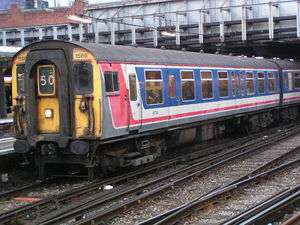
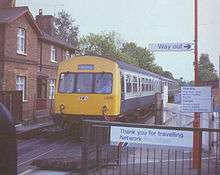
Before the sectorisation of British Rail (BR) in 1982 the system was split into largely autonomous regional operations: those operating around London were the London Midland Region, Southern Region, Western Region and Eastern Region. Sectorisation of BR altered this setup by instead organising by the traffic type: commuter services in the south-east of England, long distance intercity services, local services in the UK regions, parcels and freight. The aim was to introduce greater budgetary efficiency and managerial accountability by building a more market-focused and responsive business, rather than privatising BR outright. It was expected that the London and South East sector would cover most of its operating costs from revenues, in contrast to heavily subsidised rural services.[1]
Upon sectorisation, the London & South Eastern sector took over responsibility for passenger services in the south-east of England,[2] working with the existing BR business units of Regions and Functions to deliver the overall service. Day-to-day operation, staffing and timetabling continued to be delivered by the Regions – and the sector came into existence with barely thirty staff based at Waterloo.[3]
On 10 June 1986, L&SE was relaunched as Network SouthEast, along with a new red, white and blue livery.[2][4][5] The relaunch was intended to be more than a superficial rebranding and was underpinned by considerable investment in the presentation of stations and trains, as well as efforts to improve service standards.[3] This approach was largely brought about by a new director, Chris Green, who had presided over similar transformation and rebranding of ScotRail.
Although NSE did not originally own or maintain infrastructure, it exercised control over almost all carrier core functions. NSE set its own goals and service standards in consultation with BR, and created its own management structure and oversight. BR allowed NSE to decide about scheduling, marketing, infrastructure enhancements, and rolling stock specifications on NSE-assigned lines and services.
In April 1990, British Rail Chairman Bob Reid announced that sectorisation would be made complete, with regions disbanded by 1991/92 and the individual sectors becoming directly responsible for all operations other than a few core long-term planning and standards functions. Network SouthEast thus went from a business unit of around 300 staff to a major business operation with 38,000 staff and a £4.7bn asset value – large enough to be ranked as the 15th-biggest business in the UK.[3]
Network SouthEast, like each other sector, was given primary responsibility for various assets (rolling stock, tracks, stations), and control resided with the primary user. Other sectors could negotiate access rights and rent facilities, using their own resources. NSE was able to exert much greater control and accountability over both its operating budget and service quality than BR could under its Regions. Relations were generally good between NSE and other sectors, although operating pressures sometimes forced staff to use equipment and assets belonging to other sectors to meet immediate needs.
On 1 April 1994, Network SouthEast was disbanded with its operations transferred to train operating units ready for privatisation.
Network Railcard
Although NSE ceased to exist in 1994, the grouping of services that it defined before privatisation remain grouped by the Network Railcard,[6] which can be bought for £30 and which offers a 34% discount for adults and 60% discount for accompanying children after 10:00 on weekdays and all day at weekends (subject to a minimum weekday fare of £13). Holders of annual season tickets for journeys within the Network area, including on London Underground, are issued with a "Gold Card" which gives them similar privileges to the Network Railcard.


Rolling stock
| Class | Image | Number | Power | Carriages | Notes |
|---|---|---|---|---|---|
| 03* | 2 | Diesel Shunter | N/A | Shunters at Ryde depot on the Isle of Wight. | |
| 05* | 1 | Diesel Shunter | N/A | Shunter at Ryde depot on the Isle of Wight, where it earned the nickname "Nuclear Fred". Replaced by two Class 03s, currently owned by the Isle of Wight Steam Railway. | |
| 08* | 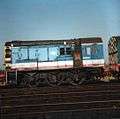 | Diesel Shunter | N/A | Examples include:
| |
| 33 |  | Diesel Locomotive | N/A | ||
| 47 |  | Diesel Locomotive | N/A | ||
| 50 |  | Diesel Locomotive | N/A | ||
| 73 | 6 | Diesel Electric Locomotive | N/A | ||
| 86 | 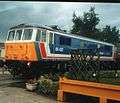 | AC Electric Locomotive | N/A | ||
| 97 | Departmental Locomotives and Shunters | N/A | Had ex-members of starred classes and worked across the NSE network. | ||
| 101 | _DMU.jpg) | Diesel Multiple Units (DMU) | 2, 3 or 4 | ||
| 104 | DMU | 2,3, or 4 | |||
| 108 | DMU | 2,3 or 4 | |||
| 115 | DMU | 4 | |||
| 117 | DMU | 3 | |||
| 119 | DMU | 3 | |||
| 121 | 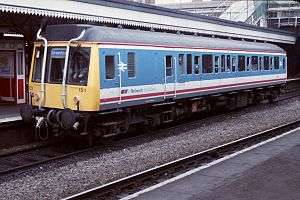 | DMU | 1 | Worked the branches of the Thames valley. | |
| 159 |  | 30 | DMU | 3 | |
| 165 | 76 | DMU | 2 or 3 | ||
| 166 | 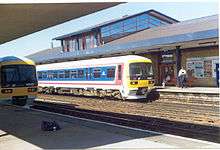 | 21 | DMU | 3 | |
| 203 | Diesel Electric Multiple Unit (DEMU) | 6 | |||
| 205 | 34 | DEMU | 3 or 4 | ||
| 207 | 19 | DEMU | 3 | ||
| 306 | AC Electric Multiple Unit (AC EMU) | 3 | |||
| 313 |  | 64 | AC EMU | 3 | |
| 315 | 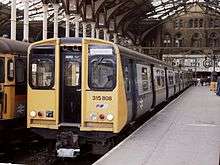 | 61 | AC EMU | 4 | |
| 316 | 1 | AC EMU | 4 | Converted to class 457. | |
| 317 | 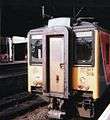 | 72 | AC EMU | 4 | |
| 319 |  | 86 | AC EMU | 4 | |
| 321 | .jpg) | 114 | AC EMU | 4 | |
| 322 | 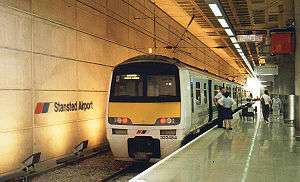 | 5 | AC EMU | 4 | |
| 341, 342 | Never built | AC EMU | Never built | These classes were put forward for the rolling stock of the original Crossrail project. | |
| 365 | 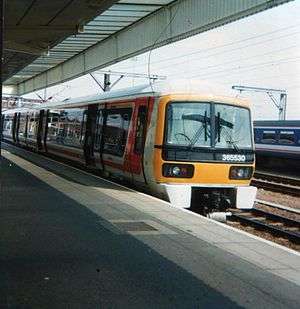 | 41 | AC EMU | 4 | |
| 371, 381, 471 | Never built | AC EMU | Never built | ||
| 411 |  | 135 | DC EMU | 4 | |
| 413 | 29 | DC EMU | 4 | ||
| 414 | 209 | DC EMU | 2 | ||
| 415 | Unknown | DC EMU | 4 | ||
| 416 | 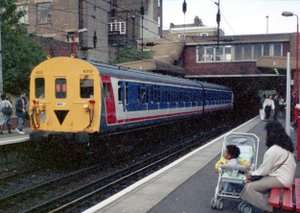 | 128 | DC EMU | 2 | |
| 419 | 10 | DC Motor Luggage Van | 1 | ||
| 421 |  | 166 | DC EMU | 4 | |
| 423 | 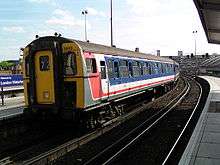 | 196 | DC EMU | 4 | |
| 432 | 15 | DC EMU | 4 | ||
| 438 | 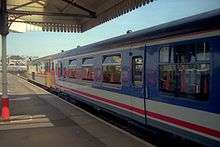 | 34 | DC EMU | 4 | |
| 442 | 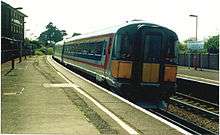 | 24 | DC EMU | 5 | |
| 455 |  | 137 | DC EMU | 4 | |
| 456 | 24 | DC EMU | 2 | ||
| 457 | 1 | DC EMU | 4 | ||
| 465 | 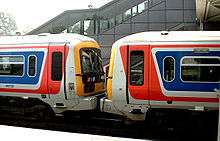 | 147 | DC EMU | 4 | |
| 466 | 43 | DC EMU | 2 | ||
| 482 | 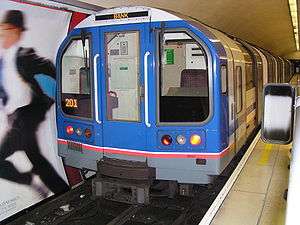 | 10 | DC Tube Train | 2 | Waterloo & City line 1992 stock, transferred to London Underground in 1994. |
| 483 |  | 10 | DC Tube Train | 2 | Works on the Island line on the Isle of Wight. Following the retirement of the Classes 485 and 486, the class became the oldest to operate on the mainline. |
| 485, 486 | 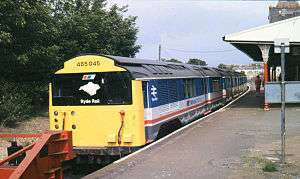 | 12 | DC Tube Train | 3 or 4 | Worked on the Island line on the Isle of Wight. Replaced by Class 483s from 1989 onwards. |
| 487 | .jpg) | 28 | DC Tube Train | 2 | Worked on the Waterloo & City line before being replaced by Class 482 in 1993. |
Subdivisions
NSE was broken down into various sub-divisions.
| Subdivision | Main Route(s) | Route Description |
|---|---|---|
| Chiltern | Chiltern Main Line, London to Aylesbury Line | London Marylebone-Aylesbury/Banbury |
| Great Eastern | Great Eastern Main Line | London Liverpool Street-Ipswich/Harwich/Clacton-on-Sea/Walton-on-the-Naze/Southend Victoria |
| Great Northern | East Coast Main Line, Hitchin-Cambridge Line | London King's Cross-Peterborough/Cambridge (and subsequently London King's Cross-Cambridge-King's Lynn) |
| Island Line | Island Line | Ryde-Shanklin |
| Kent Link | North Kent Line, Bexleyheath Line, Dartford Loop Line, Mid-Kent Line, Catford Loop Line, Hayes Line | London Victoria/Charing Cross-Dartford/Gravesend/Gillingham/Orpington/Sevenoaks/Hayes |
| Kent Coast | Chatham Main Line, Hastings Line, Sheerness Line, South East Main Line | London Victoria/Charing Cross-Margate/Dover/Folkestone/Ashford/Tunbridge Wells/Hastings (and subsequently North Downs services as far as Redhill/Three Bridges) |
| London, Tilbury and Southend | LTS Line | London Fenchurch Street - Tilbury - Southend Central - Shoeburyness |
| North Downs | North Downs Line | Reading-Guildford-Reigate-Gatwick Airport-Tonbridge |
| Northampton Line/North London Lines | West Coast Main Line, Marston Vale Line, North London Line | London Euston/Broad Street-Watford-Milton Keynes-Northampton-Birmingham, Bedford-Bletchley |
| Solent and Wessex | Portsmouth Direct Line, South Western Main Line | London Waterloo-Guildford-Portsmouth, London Waterloo-Basingstoke-Southampton-Bournemouth-Weymouth |
| South London Lines | South London Lines, Oxted Line, Sutton & Mole Valley Lines | London Victoria & London Bridge to Croydon
London Victoria-East Grinstead/Uckfield/Sutton/Epsom Downs/Dorking/Horsham |
| South Western Lines | Alton Line, Waterloo-Reading Line South West London Suburban services via Wimbledon or Richmond to Chessington South/Epsom/Dorking/Effingham Junction/Guildford/Hampton Court/Woking/Weybridge/Hounslow loop/Windsor/Shepperton/Kingston loop. | London Waterloo-Alton/Reading/Windsor/Guildford/Epsom/Chessington South/Dorking/Hampton Court/Kingston Circle/Shepperton/Hounslow Circle/Weybridge |
| Sussex Coast | Brighton Main Line, Arun Valley Line, East Coastway Line, West Coastway Line | London Victoria/London Bridge-Gatwick Airport-Brighton/Eastbourne/Littlehampton, Brighton-Hastings, Brighton-Portsmouth-Southampton |
| Thames | Great Western Main Line, Cotswold Line Windsor branch | London Paddington-Slough- (-Windsor-) Reading-Oxford-Worcester/Stratford |
| Thameslink | Thameslink | Bedford-Luton-London-Gatwick Airport-Brighton |
| Waterloo & City | Waterloo & City line | Waterloo-Bank |
| West Anglia | Fen Line, Lea Valley Line | London Liverpool Street-Harlow-Cambridge-King's Lynn (express services to Cambridge, and almost all services to King's Lynn, were subsequently transferred to the Great Northern route from London King's Cross); London Liverpool Street-Stansted Airport, and local services: Liverpool Street-Chingford, Liverpool Street-Enfield Town, Liverpool Street-Cheshunt (via Seven Sisters), and Liverpool Street-Hertford East/Broxbourne (via Tottenham Hale). |
| West of England | West of England Main Line | London Waterloo-Basingstoke-Salisbury-Exeter |
Modernisation
Soon after conception, Network SouthEast started to modernise parts of the network, which had become run down after years of under-investment. The most extreme example was the Chiltern Lines.
Chiltern Lines
The Chiltern Line ran on two railway lines (Chiltern Main Line and London to Aylesbury Line) from London Marylebone to Aylesbury and Banbury. These lines were former GWR and GCR intercity lines to Wolverhampton and Nottingham respectively. After the Beeching Axe in the 1960s, these lines became seriously run down with a lack of investment and a reduction of services.
By the late 1980s, the 25-year-old Class 115s needed replacement; the lines had low speed limits and were still controlled by semaphore signalling from the early 1900s; and Marylebone was served only by infrequent local trains to and from High Wycombe and Aylesbury.
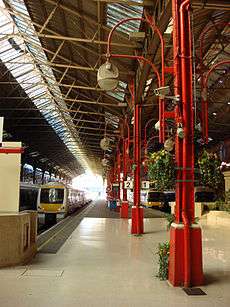
NSE realised that something needed to be done to these lines quickly. Numerous plans for the lines were proposed. One serious plan was to close the line between Marylebone and South Ruislip/Harrow-on-the-Hill, and convert Marylebone into a coach station. Metropolitan line trains would be extended to Aylesbury and BR services from Aylesbury would be routed to London Paddington via High Wycombe. Also the line north of Princes Risborough would close. However, this did not happen as Baker Street and London Paddington would not have been able to cope with the extra trains and passengers.
What did happen was total route modernisation. This was an ambitious plan to bring the lines into the modern era of rail travel. Class 115s were replaced by new Class 165s. Semaphore signals were replaced by standard colour light signals and ATP was fitted on the line and trains. Speed limits were increased to 75 mph (only 75 due to running on London Underground track between Harrow and Amersham), all remaining fast loops at stations were removed and the line between Bicester North and Aynho Junction was singled. Stations were refurbished and even reconstructed (£10 million spent on stations alone), and signal boxes and the freight depots/sidings were demolished. Regular services to Banbury, and a few specials to Birmingham were introduced and a new maintenance depot was built at Aylesbury. This was a massive undertaking and work began in 1988 and by 1992, the route had been completely modernised, demand for the service had grown considerably and the route had become profitable.
Since modernisation the route has seen further improvements (see Chiltern Main Line).
Electrification was considered but was deemed to be too expensive as the Thames Line sector would then have to be electrified as well. Another reason electrification did not take place was that some part of the line ran on underground lines, which were electrified as 4-rail 660 V DC, while British Rail preferred 25 kV AC overhead traction for lines north of London.
Success of the modernisation implemented by NSE has made it possible for the Chiltern Main Line to compete with the West Coast Main Line between London and Birmingham, and there are now plans to increase speeds and quadruple sections of the line,[7] returning the line to the state it was before the Beeching Axe.
New trains
Network SouthEast started a programme of replacing old rolling stock up to privatisation.
- Chiltern - 165
- Great Eastern - 321
- Great Northern - 365
- Island Line - 483 ex (London Underground 1938 Stock)
- Kent Coast - 465, 466, 365
- North Downs - 165, 166
- Northampton Line - 321
- Solent and Wessex - 442
- South London Lines - 456
- Thames - 165, 166
- Thameslink 319
- Waterloo & City - 482 (London Underground 1992 Stock)
- West Anglia 315, 317, 322
- West of England 159
Privatisation
During the privatisation of British Rail, NSE was divided up into several franchises:
| Original franchise | Route(s) | Currently |
|---|---|---|
| LTS Rail | London, Tilbury & Southend | Rebranded c2c |
| Chiltern Railways | Chiltern Main Line, London to Aylesbury Line, Princes Risborough to Aylesbury Line, Leamington to Stratford Line and the Oxford to Bicester Line | Unchanged |
| Great Eastern Railway | Great Eastern | Rebranded as First Great Eastern, then merged into larger franchise operated by National Express East Anglia, then passed on to Abellio Greater Anglia in 2012 |
| Thames Trains | Thames North Downs (Gatwick/Redhill - Dorking/Guildford/Reading section) | Franchise passed to First Great Western Link, later merged into larger franchise operated by First Great Western (later Great Western Railway) |
| Island Line | Island Line | Operated by Stagecoach from 1996 until 2017 retaining Island Trains brand, now operated by South Western Railway |
| North London Railways | Northampton Line North London Line | Rebranded as Silverlink, later split up into two franchises operated by London Midland (Northampton) and London Overground (North London) |
| South Eastern | Kent Coast, Kent Link, North Downs (Tonbridge- Redhill section) | Rebranded as Connex South Eastern, then passed to South Eastern Trains, then to Southeastern |
| Network SouthCentral | South London Line Sussex Coast | Rebranded as Connex South Central, then passed to Southern |
| Thameslink | Thameslink | Merged into larger franchise operated by First Capital Connect, became part of Govia Thameslink Railway in 2014 |
| West Anglia Great Northern | Great Northern West Anglia | Split with GN merged into First Capital Connect, now part of Govia Thameslink Railway) and WA merged into National Express East Anglia, then passed on to Abellio Greater Anglia in 2012. Some of the Abellio Greater Anglia lines have been passed onto TfL Rail (part of Crossrail) and London Overground |
| South West Trains | Solent & Wessex South Western Line West of England Line | Operated by Stagecoach from 1996 until 2017, but retained South West Trains branding, now operated by South Western Railway |
One element of NSE that remained in public ownership was the Waterloo & City Line; too small to be operated as a self-contained franchise, it was not incorporated with the rest of NSE services from Waterloo into the South West Trains operation, and was instead transferred to London Underground.[8]
Legacy
Although NSE ceased operations in 1994, its logos, livery and signage would linger well into the following decades. The Southeastern and Southern train companies still ran trains painted in NSE livery as recently as 2006/2007, ten years after privatisation; and some stations on the Moorgate branch of the Great Northern route (Highbury & Islington, Essex Road, Old Street and Moorgate) still have the NSE era colour schemes as of July 2018 – even though they have been through 3 new operators after privatisation (WAGN from 1994 to 2006, First Capital Connect from 2007 to 2014 and Great Northern, under Govia, from 2014).
NSE signage and logos can also be found across the Island Line, Isle of Wight, with particularly well-maintained examples existing at the Ryde Pier Head and Shanklin ticket offices.
The last train still in NSE livery was withdrawn on 15 September 2007 when 465193, was sent for revinyling.[9]
On 28 August 2015, the Network SouthEast Railway Society, obtained the trademark of Network SouthEast's brandname, logo and typeface[10]. The group wanted to obtain the trademark to help Network SouthEast's name and legacy live on following its demise and educate about NSE[11].
In 2017, the Railway Heritage Trust collaborated with train operator Govia Thameslink Railway to recreate the Network SouthEast image at Downham Market station as a commemorative measure. The station has been equipped with paintwork and signage that mimic the Network SouthEast branding of the late 1980s.[12]
References
- ↑ Mark Lawrence: Network SouthEast - From Sectorization to Privatisation. Sparkford, Oxford Publishing Co. 1994
- 1 2 Thomas, David St John; Whitehouse, Patrick (1990). BR in the Eighties. Newton Abbot: David & Charles. ISBN 0-7153-9854-7.
- 1 2 3 Green, Chris; Vincent, Mike (2014). The Network SouthEast Story. Oxford Publishing Co. ISBN 9780860936534.
- ↑ "Network SouthEast". Jane's Railway Year. 6: 4–11.
- ↑ "How the Network SouthEast was won" Rail Magazine issue 747 30 April 2014 page 72
- ↑ "Network Railcard". Archived from the original on 2 November 2007. Retrieved 2 November 2007.
- ↑ "Network Rail route plan for Chilterns November 2007" (PDF).
- ↑ "Waterloo & City Line". Clive's Underground Line Guides. Clive Feather. 14 December 2007. Retrieved 30 June 2008.
- ↑ "After 21 years, no more NSE" Rail Magazine issue 575 26 September 2007 page 9
- ↑ Intellectual Property Office (28 August 2015). "Trade mark number - UK00003110943". trademarks.ipo.gov.uk. Retrieved 23 May 2018.
- ↑ Shepherd, John (6 October 2016). "Network SouthEast TRADEMARK INFORMATION". Network SouthEast Railway Society. Retrieved 23 May 2018.
- ↑ Heritage makeover unveiled at Downham Market railway station Lynn News 4 May 2017
Further reading
- Brown, David; Jackson, Alan A. (1990). Network Southeast Handbook. Capital Transport. ISBN 978-1-85414-129-3.
- Green, Chris; Vincent, Mike (2014). The Network SouthEast Story. OPC. ISBN 9780860936534. OCLC 872707499.
- British Railways Board: London and South East Commuter Services, 1980 Competition Commission report
- British Railways Board: Network South East, 1987 Competition Commission report
- "Network SouthEast: Planning for the 1990s". Rail Magazine. No. 88. EMAP National Publications. January 1989. Supplement (32 centre pages). ISSN 0953-4563. OCLC 49953699.
- "Network SouthEast: The prospects ahead". Rail Magazine. No. 107. EMAP National Publications. 19 October – 1 November 1989. pp. 24–31. ISSN 0953-4563. OCLC 49953699.
External links
| Wikimedia Commons has media related to Network SouthEast. |